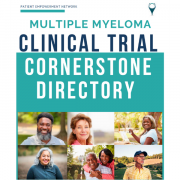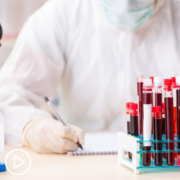What Do Myeloma Test Results Reveal About Prognosis and Treatment?
What Do Myeloma Test Results Reveal About Prognosis and Treatment? from Patient Empowerment Network on Vimeo.
Myeloma expert, Dr. Saad Usmani, discusses how risk stratification is used in the care and treatment of patients with myeloma. Dr. Usmani reviews important test results that are used to classify low- and high-risk myeloma and the impact on treatment choices.
Dr. Saad Usmani is the Chief of Myeloma Service at Memorial Sloan Kettering Cancer Center in New York City. Learn more about Dr. Usmani, here.
Related Programs:

|

|

How Does Essential Testing Affect Myeloma Care and Treatment? |
Transcript:
Katherine Banwell:
How can the results of these tests affect prognosis and treatment?
Dr. Usmani:
So, currently for the most part, we’re treating myeloma patients in a similar fashion. Except for some tweaking based on these quote unquote high-risk features. So, there are certain chromosomes abnormalities that tell us that a patient has a higher chance of relapsing early even if they get the standard of care treatment. So, we try to enroll those patients into a clinical trial or have better optimization of their induction treatment and their maintenance strategy.
So, identifying these high-risk abnormalities is important because our treatment decisions may be modified for that patient’s disease. Or we might be able to get them to a clinical trial sooner than later.
Katherine Banwell:
Right. What is risk stratification? And how is it used in patient care?
Dr. Usmani:
So, risk stratification helps us identify people who are going to do well in terms of getting to a good response and maintaining that response and maintaining being progression free or being disease free versus those folks who maybe relapsing sooner. And that’s called risk stratification. So, you are essentially identifying and dividing patients into two different buckets saying, “All right. I have to pay attention to this person a bit more because they can relapse soon. So, I’m going to be keeping an eye on their labs and such very much, much closely.”
Katherine Banwell:
Let’s talk about therapy for myeloma patients. How are low-risk patients treated?
Dr. Usmani:
So, typically, the low or standard risk patients are treated with at least a three-drug induction treatment at the time of diagnosis. Or sometimes with four-drugs if you combine an antibody treatment. There are various regimens but the standard of care is at least three drugs. Then for patients who may be eligible for a stem cell transplant, they go on to receive autologous stem cell transplant. Once they’ve recovered from the stem cell transplant, they go on to maintenance treatment.
And the idea is that the induction along with stem cell transplant for those patients who are eligible gets patients to as deep as a response as possible. And the concept of maintenance is you maintain them in that response and delay the disease from coming back.
Katherine Banwell:
Right. And then what about high-risk patients? How are they treated?
Dr. Usmani:
So, for high-risk patients, we typically prefer using a four-drug regimen. Either daratumumab RVD or carfilzomib with Len Dex or KRD as induction treatment for high-risk patients. After the stem cell transplant, most patients would continue both the lenalidomide as maintenance along with the proteasome inhibitor. If patients had low or standard risk disease, they would only be getting lenalidomide as maintenance. So, here for high-risk patients, you’re adding a proteasome inhibitor.










